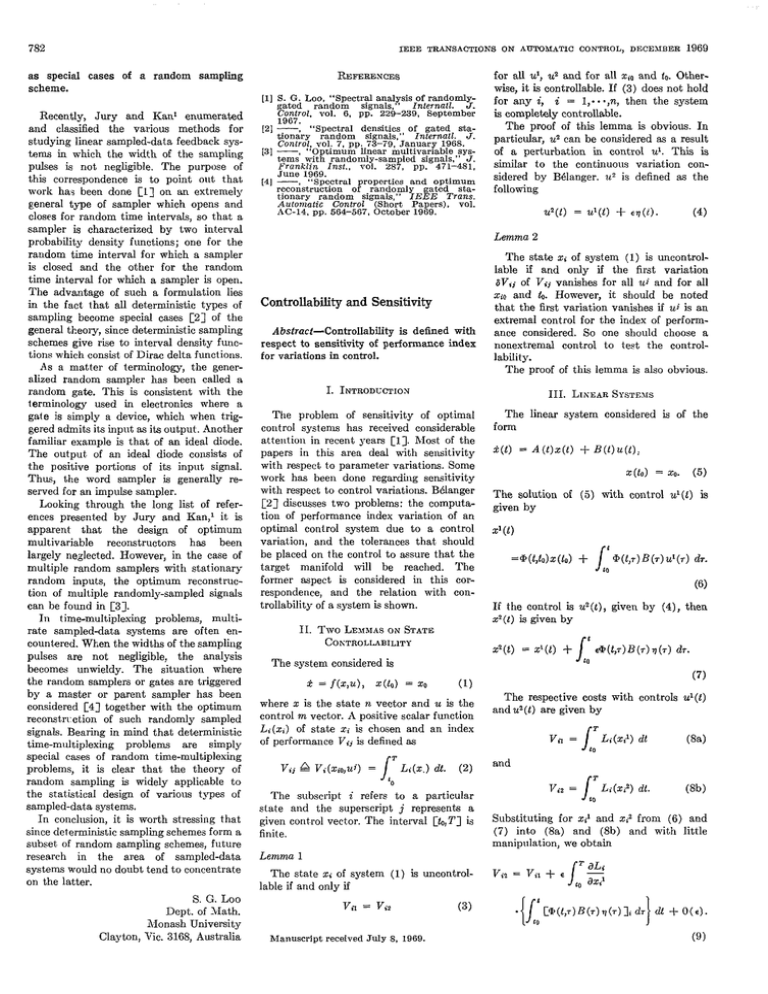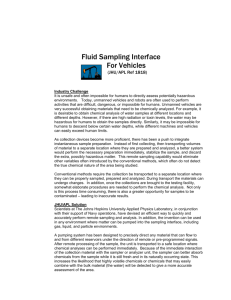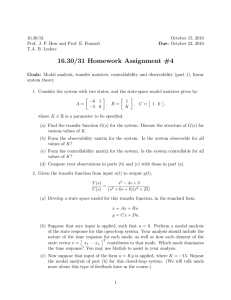Document 13677590
advertisement

782 IEEE T I M N S - A ~ O E ; ~ON AUTOELTIC a s special cases of a randomsampling scheme. Recently, JuryandKanlenumerated and classified the various methods for studying linear sampled-data feedback systems in xhich the width of the sampling pulses is not negligible. The purpose of this correspondence is topoint out. that work has been done [l] on an extremely general type of sampler which opens and closes for random time intervals, so that a sampler is characterized by two interval probabilitydensityfunctions; one for the random time interval for which a sampler is closed andthe ot,her forthe random time interval for d i c h a sampler is open. The advantage of suchaformulation lies in the fact that all det.erminiitic types of sampling become special cases [2] of the general theory, since deterministic sampling schemes give rise to interval density functions which consist of Dirac delta functions. As a matter of terminology, the generalized randomsamplerhas been called a randomgate. This is consistent withthe terminology used in electronics where a gate is simplya device, which when triggered admits its input as its output.Anot.her familiar example is that of an ideal diode. Theoutput. of an ideal diode consists of the positive portions of itsinput signal. Thus,the word sampler is generally reserved for an impulse sampler. Looking throughthe long list of references presented byJuryandKan,lit is apparent that the design of optimum multivariable reconstructors has been largely neglected. However, in the case of multiple random samplers with stationary randominputs,the optimum reconstruct.ion of multiple randomly-sampled signals can be found in [a]. In time-multiplexing problems, multiratesampleddata systems are oftenencountered. When t.he widths of the sampling pulses are not negligible, the analysis becomes unwieldy. Thesituation where the random samplers or gates are triggered by a master or parent sampler has been considered [4] together with the optimum reconst,rrction of suchrandomlysampled signals. Bearing in mind that deterministic time-multiplexing problems are simply special cases of random time-multiplexing problems, it is clear that.the t.heory of random sampling is widely applicable t o the stat.istica1 design of variomtypes of sampled-dat,a systems. I n conclusion, it is worth stressing that since deterministic sampling schemes form a subset, of random sampling schemes, fut.ure research in the area of sampled-data systems would no doubt tend toconcentrate on the latter. S. G. Loo Dept. of Math. Atonash University Clayton, Vic. 3168, Australia REFERENCES [l] S. G . Loo, “Spectral a n a l p of randomlygated random signals Internatl. J. CoFpoZ, vol. 6. pp. 22b-239, September 1Yti7. , “Spect.ra1 densities,, of mated staI n b m t Z . J. tionary random signals Conlrof: vol. 7 pp. 73-79 ’January 1968. - Optimbm linear multivariable systams‘ withrandomly-sampledsignals,” J. Franklin Inst., 287, pp. 471-481. June 1969. “Spectral propertiesandoptimum reco&uction of .rando,@y gated st,aI E E E Trans. tionary ra.ndom sLgals Automatic Control (Shdrt Papers). vol. AC-14, pp. 564-567, October 1969. 1701. COATROL, DECEMBER 1969 for all u’,u2 and for all zio and to. Otherwise, it is controllable. If ( 3 ) does not hold thenthe system for any i, i = l,---,n, is completely controllable. The proof of this lemma is obvious. I n particular, u2 can be considered as a result of a perturbation in cont.ro1 ul. This is similar tothe continuous variation considered by BBlanger. u 2 is defined as the following U * ( t ) = u’(t) +q(t). (4) Lemma 2 Controllability and Sensitivity Abstract-Controllability is defined with respect to sensitivity of performance index for variations in control. I. The state zi of system (1) is uncontrollable if and only if the firstvariation 6Vii of Vij vanishes for all ui and for all z i p and h. However, it&odd be noted that the first variabion vanishes if uf is an extrema1 control for the index of performance considered. So one should choose a nonextremal cont.ro1 to testthe controllability. The proof of this lemma is also obvious. INTRODUCTION 111. LIKEAR SYSTEMS The problem of sensitivity of opt.ima1 controlsystemshas received considerable attention in recent rears [l]. Most of the papers in thisarea dealwith sensitivity with respect to paramet.er variations. Some work has been done regarding sensitivity wit.h respect to control variations. BBanger [2] discusses two problems: the computatiou of performance index variation of an optimalcontrol syst,em dueto a control variation, andthe tolerances that. should be placed on the control to assure that the target manifold will be reached. The formeraspect is considered in this correspondence, and the relation with controllability of a system is shown. The linear system considered is of the form 2(t) = A(t)x(t) z(t0) = 1:o. STATE COXTROLLABILITY (1) If the control is u2((t),given by (4), then ‘ ( t ) = z‘(&) -k The system considered is Vi(Zi0,Ui) = 1: Li(X.) dt. (2) The subscript i refers to a particular stateandthe superscript j represents a given cont.ro1vector. The interval [ h , T ] is finite. Lemma 1 The state zi of system (1) is uncontrollable if and only if vir = vc2 Manuscript received July 8, 1969. L: & ( ( t , T ) B ( 7 ) 7 ) ( 7 ) dT. (7) (1) where 1: is the state n vector and u is the control m vector. A posit.ive scalar function Li(zi) of state zi is chosen and an index of performance V i j is defined BS vij P given by T W O LE?.iXAS O N 2 = f ( x , u ) , x(&) = 1:o (3) (5) The solution of ( 6 ) with control ul(t) is given by z z ( t ) is 11. +B(t)U(l), The respective costs with controls d ( t ) and u2(t) are given by v~Y = 1: Li(z2) dt (Sa) and Substituting for xi1 and x? from (6) and (7) into (Sa) and(8b)and with little manipulation, we obtain 783 CORRESPONDEKCE Partial Fractiwn Expansion of a Special Tmnsfer X&ix CONSTRUCTION O F A CONTROLL4BLE REALIZATION Therefore, The method given' uses Z ( s ) e q a n d e d into its partialfractions Consider a matrix M(s) of the special form Z(s) If xi is uncontrollable, by Lemma 2, + ... + X 6TTG = 0. (11) From a well-known lemma of calculus of variations [SI, (11) implies /I: [ @ ( t , ~ ) B 7( r( 7) ) ] idr = 0. IV. CONCLUSION It is shown t,hat controllability is equivdenttothe fireborder sensitivit.. of an index of performance depending on a particular st.ate. 8. SARMA SAHJESDR.4 x. S l N G H Dept. of Elec. Engrg. Indian Institute of Science Bangalore 12, India REFERENCES [11 31. Sobral, "Sensitivity in optimal control systems," Proc. I E E E , 001. 66, pp. 16141652, October 19I3,S. [ 2 ] P. R . BBlanger, Some aspects of control tolerances and first-order sensitivity in optimal control systems," I E E E Trans. A u t o n ~ ~ t iControl. c vol. 4C-11. . DII. * 7;-83. January 1966. ' 131 G . A . Bliss, Lectures on Calculus of V a r i a Lions. Chicago, Ill.: University of Chicago Press, 1961. ~ h ( s ) . g ( s ) / ( s - X)' (4) where h ( s ) is a polynomial column and g(s) a polynomial row of degrees less than T. -4 Taylor expansion gives for Z ( s ) ( s - X)' It requires the computation of the independent. rows in the matrices (12) Equation (12) implies uncontrollability of state xi. v. 1'. ] = Then, these rows are utilized to express t.he matrices M i as a sum of a number of matrices wit.h rank 1 (i.e.,product, of a column by arow). This form is rat.her difficult to obtain and a direct method as explained in [l] is to be preferred. Using t.he Leibnitz formula, (3) and (4) are the sameif and only if hence, the direct realization by (6) of a transfer matrix mitten as (4). Trayfeer Matrix Corresponding to a Jordan. Bloc COJIPREHEXSIVE REALIZATION According to Smith and Frobenius [2], any polynomial mat.rix can be splitinto Let. the system be defined by ;i: = Fx + Gu R (2 1 y = Hx where F is assumed to be an upper Jordan bloc r X r: J(X,r). The corresponding transfer matrix k given by Z(S) = H ( s I - J(X,?))-'G = HBG with [ 2 ] I 5 = - J@,r))-I (SI 1 1 ( s - X) ( s - X)' ~~ ... 1 ~ ( s - X)' h ( s )' g k ( s ) . U(s) = k=l These quantities for the various h(s) and g(s) have proved to immediat.ely provide an irreducible rea.lization for Z ( s ) [3], [4]. But. the act,ual compuhtion of these terms is rather difficult., and it k easier to deal with the columns (orroas) of M ( s ) in spite of the requiredreduction procedure. Let m r ( s ) be the columns of M ( s ) , and Put hk(s) = mn(s), gk(s) = [ O m .-010. - -01 with 1 in the kth column. Therefore, m M(s) = Comments on "Irreducible Jordan Form Realization of a Rational Matrix" . In a recent paper', S. P. Pandaand C. T. Chenhavestudied the construction of an irreducible realizat.ion for a transfer matrix of the form Z(s) = M ( s ) / ( s - X)' . 0 (1) where M ( s ) is an n X m-polynomial matrix. The solution 60 this problem has already been given in [I] using, as in t.he previous paper, a two step procedure: servable) realization; 2) reduction of this model by eliminating the possible unobsewable (uncontrollable)parts. 1969. 1 S. P..Panda and C. T.Chen, I E E E T r a n s . Autonzatzc Control (Short Papers), vol. AC-14. pp. 66-69, February 1969. 0 (s - 1 1 ( s - X) Consider now the general form of (2), with P = dia.g [Jl,Jp, -,JR]and H and G partitioned according to F. The transfer matrix is -- Z(S) - Writing down the columns of H and r0-m of G as H ( s I - F)-'G R R Hk(sI - Jk)-'Gk b=1 1) construction of a controllable (ob- h,Ianuscript received June 5 , hk.gk. k=l HLFkGn. = (7) k=1 Hence, using (7) and (6), a comprehensive realization of (1) is easily obtained as the composition of each elementary r X r realization of transfer matrix (4). REDITTIONOF THE REALIZATION results in The method proposed byPandaand Chenl is based on the computat.ion of a transformation m a t r k T that commutes with t.he Jordan form of matrix F and allows the elimination of the unobservable parts of the realization. This global transformation depends on a number of param-





